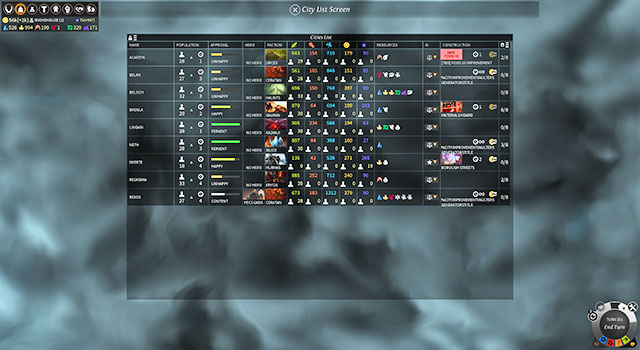Cities | Empire management
Last update:

To a large extent, specialization of a city depends on the tasks assigned to citizens, and not on the buildings. Production buildings are so few in numbers that you can have in each city, with a bit of planning. Especially that some of them function only near rivers, sea or rocky areas. The amount of buildings will only be a problem in the case of new cities under development. Still, sooner or later, also they will be able to erect them all. Therefore, while deciding on the order in which to build them, pay attention to what you need at the moment. Leave the rest of them for later.
Cities can specialize in:
- Food production. It is a good idea to focus on this one, for a certain amount of time, to ensure cities with high population, after which you assign citizens to other tasks. In the long run, it is not beneficial, because the city obtains materials from the surrounding fields, regardless of its current population. Focusing on food production means only that large portion of the citizens will be assigned to food production.
- Industrial production. Focus on this if the production queue is long, or you are at war and you need new soldiers. In the peace time, in a city with the majority of important buildings erected, it is best to focus on something else. With the exception of making provisions. For such times, you can single out one industrial city, for the time of peace.
Scientific production. A field that is key to everyone. There should be, at least, one city that specializes in science, so there is anything to manufacture, for the rest of them.
Dust production. Again, important for all factions. Many special abilities, the market or buying buildings requires Dust. Have, at least, a half of your cities, focus on Dust production.
Influence points production. You need these points to determine the imperial plan, for diplomacy or for assimilation of the minor factions. A small empire will do with just one city that specializes in that. A big one requires two, or even three.
Later into the game, buy cheaper buildings, such as the foundry or library, and build the more expensive ones yourself. This will also allow you to found cities on the less hospitable terrain. For example, if you are founding a city on fields devoid of food, you will be able to make up for that, thanks to Seed Storages (the first era) and Public Granary (the second era). Therefore, you should not be afraid to experiment with location of cities, because there are many ways to improve on their condition.
Do not found cities near the deposits of strategic resources or luxury resources. Especially if there are much better locations around. Mines do not need to be located near cities, for proper functioning and you will not be able to benefit from anomalies, and the other valuable areas, without a city. And you should, because anomalies provide many useful bonuses and they are, usually, more profitable for cities, than simple forests or plains. Still, if you really need to build a city near a deposit of a resource, remember that each district works like a mine. However, you cannot build a district over a mine that has already been built. Therefore, try not to build it where you have planned previously, or build a district later on.
Try not to found cities in the neighborhood of ruins. You will be using the field that they are located on, but you will be unable to build a district there. This means that one of the six development paths will be blocked off, which may be quite a problem for a newly-founded city.
Remember that the number of districts, in a city, depends on its population. It is especially important in the case of Broken Lords, who need to buy each new citizen. If your food production is low, you need to realize that your city is going to be small. In such a case, consider and reconsider founding a city in the given area, because it may turn out that you will not be able to expand it in the way you wanted.
As you build more districts, consider if you want to boost the level of the ones that already exist, or maybe seize as many fields as possible. A district progresses to the second level, if it is surrounded with four other districts. Thanks to this, it yields more Influence Points. On the other hand, however, the reach of districts built one next to another is shorter. Each time you want to build a new district, find out how many fields it is going to encompass. Note that sometimes it is going to be three fields, sometimes two and sometimes just one. Therefore, you need to decide - either as many fields as possible, or a higher level of districts. You cannot have it both ways. You will either run out of time, or resources, or citizens.
If the valuable fields, or anomalies, are at a considerable distance from each other, ignore them. You can simply run out of time to build a district that would encompass them. If a valuable field is within the distance of two or three hexes of the city, it is worthwhile trying to reach them. If it is farther away, ignore it. If there are several such locations to choose from, try to reach one, or two at most.
After all, the meaning of anomalies drops later into the game, when shortages in cities can be dealt with, y means of buildings it founding new cities loses in importance. This does not mean, however, that you can erect them without any plan on your mind. Simply, with the option to buy the majority of important buildings, or making use of food provisions and industrial provisions, you do not need to stick to as many instructions as in the initial turns.
Note land formation. Some of the elevations can be climbed on two sides, whereas the other only on one side. If you found a city in such a location, you will make it more difficult for the enemy to siege it, because you will know where the enemy armies stop. If, however, one of the districts is below the elevation, the siege may start on that side. However, it is difficult to find a vast area entirely on an elevation so, do not worry if the better areas increase the chance of siege.
All you need for seafaring is the Cargo Docks (the second era) technology. Therefore, not all cities in coastal areas need to be harbor cities.
If you do not have time, or any idea on how to develop a city, use the option of automatic building. The computer is nothing of a genius, but it can properly manage the city, while adhering to your instructions.
You are not permitted to copy any image, text or info from this page. This site is not associated with and/or endorsed by the Iceberg Interactive or Amplitude Studios. All logos and images are copyrighted by their respective owners.
Copyright © 2000 - 2025 Webedia Polska SA for gamepressure.com, unofficial game guides, walkthroughs, secrets, game tips, maps & strategies for top games.
